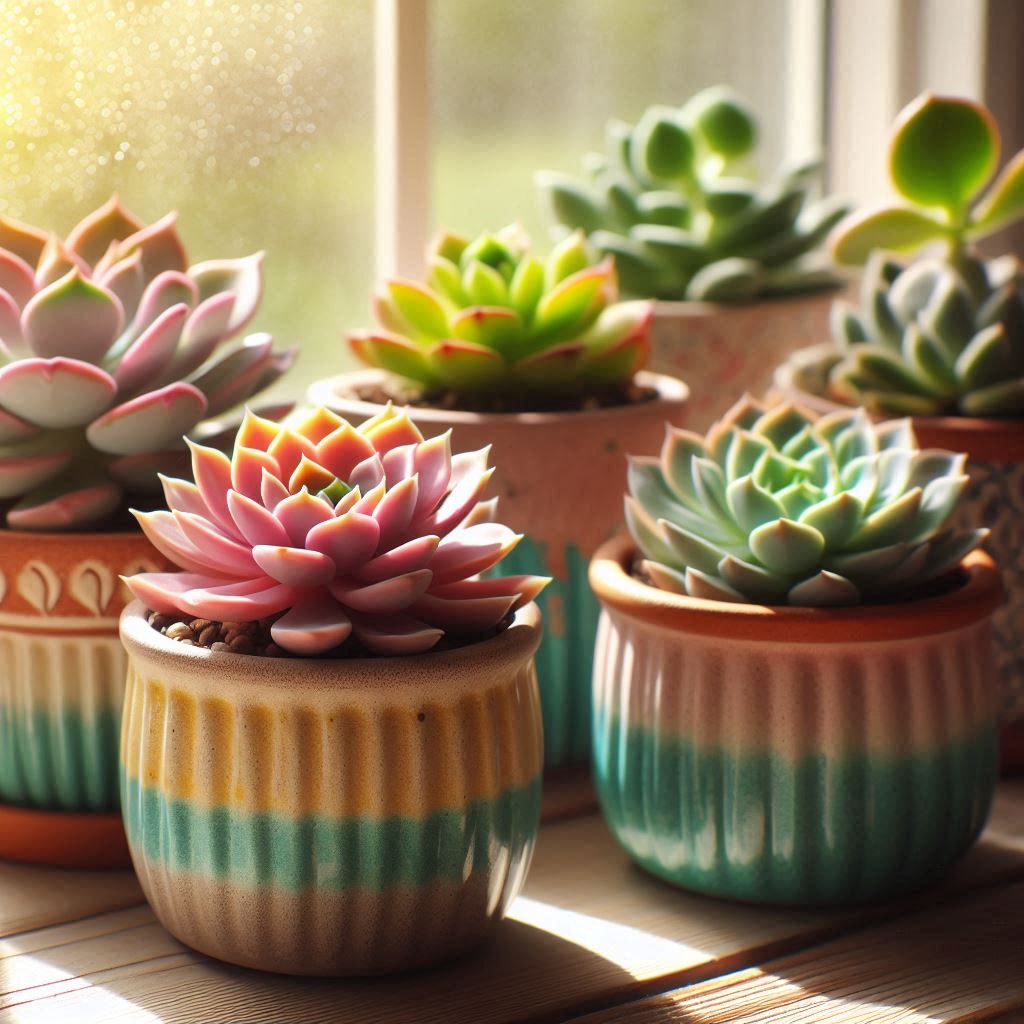Can succulent plants survive winter? While these hardy plants may seem fragile, with the right care, they can thrive even in chilly conditions. Succulents are known for storing water, which makes them resilient in dry conditions but exposed leaves can suffer in freezing climates. In this guide, we’ll explore how to protect your succulents during the cold months, explore different varieties, and discover methods to maintain their health and vibrancy. With simple precautions and knowledge, you can keep your succulents safe all winter long.
How Cold Weather Affects Succulent Plants’ Survival
When winter’s chill descends, succulent plants face challenges that can affect their survival. Cold temperatures can push these hardy plants to their limits. Yet, armed with the right knowledge, you can ensure their survival through even the harshest winters. Succulents naturally store water in their leaves, making them drought-resistant, but this characteristic also makes them vulnerable to frost.
Freezing Temperatures
When temperatures drop below freezing, the water stored in succulent leaves can freeze, causing cell damage and potentially killing the plant. However, some succulent species have developed adaptations to withstand cold climates. Understanding these protective measures can help in safeguarding your plants.
Insulation Through Mulch
Insulating the soil with a layer of mulch can mitigate the impact of cold weather. Mulch acts as a barrier, retaining warmth in the soil and preventing roots from freezing. This practice is particularly effective for outdoor succulents exposed to fluctuating winter temperatures.
Adapting to Dormancy
Some succulents enter a state of dormancy during the winter months. In dormancy, growth slows down, conserving energy and increasing survival chances. Observing your plant’s behavior can offer clues about their dormancy cycle, allowing you to adjust care routines accordingly.
By understanding how cold weather affects your succulents, you can take specific actions to protect and help them thrive year after year. Armed with the right techniques and strategies, you can transform your winter garden into a sanctuary for these resilient beauties.
Which Succulent Species Are Hardy Enough to Survive Winter?
Some succulent species are tough enough to withstand chilly winter temperatures. Sempervivum, also known as ‘Hens and Chicks’, is particularly cold-hardy and can survive outdoors even in snowy climates. These resilient plants boast thick leaves that store water, enabling them to endure through harsh weather conditions. Sedum, another robust variety, often referred to as ‘Stonecrop’, can also tolerate cold spells. Their ability to thrive in low temperatures makes them an excellent choice for outdoor gardens or rockeries.
Agave
species are known for their durability in colder climates, with several varieties growing successfully in frosty conditions. These succulents usually have a waxy coating on their leaves, which helps protect them from freezing temperatures. Additionally, specific types of Echeveria exhibit winter hardiness, although they typically require some protection from extreme cold and snow. By selecting these resilient succulent species, you can ensure your winter garden remains lively and beautiful, even in the coldest months.
Preparing Your Succulents for the Winter Season
When winter approaches, it’s essential to start preparing your succulents to endure the cold months ahead. While these hardy plants are known for their resilience, some may need extra care to survive lower temperatures.
Begin by assessing the space where your succulents are planted. If they are outdoors, consider moving them to a sheltered spot, such as under a porch or against a south-facing wall, to shield them from chilly winds. Boarding them up with a frost cloth or burlap can also add an extra layer of protection against harsh weather conditions.
Adjusting Watering Routines
One of the critical aspects of winter care for succulents is adjusting their watering schedule. Water them less frequently, as these plants need to remain dry during colder months to prevent root rot. Ensure the soil is thoroughly dry between waterings, which are likely to be spaced out by a week or more compared to the growing season.
Soil and Pot Considerations
Confirm that your succulents are in well-draining soil during winter, as stagnant moisture can lead to damage. If they are in pots, make sure the containers have adequate drainage holes and elevated positions that prevent water from accumulating at the base.
Watch out for signs of stress, like leaf shriveling or discoloration. These indicate that your succulent might be receiving too much moisture or cold exposure and should be moved to a warmer spot.
By taking proactive steps in preparing a safe and suitable environment, you enable your succulents to thrive despite the winter challenges. With a little extra care, these beautiful plants can continue to enhance your space year-round.
How to Protect Succulents from Freezing Temperatures
During the colder months, ensuring your succulents are safe from freezing temperatures is vital to their survival. Freezing temperatures can cause cell walls to break, leading to mushy and damaged plants. To shield your succulents from the cold, start by relocating them to a more sheltered area, like a patio or covered porch. Covering your plants with frost cloths or blankets can provide extra protection. This creates a barrier that traps the heat from the ground, keeping the cold air away from the plants.
Water your succulents sparingly during the winter. Water sitting in the soil can freeze and subsequently expand, which can damage the roots and base of your plants. Allow the soil to dry out completely between waterings to avoid these issues. It’s also beneficial to consider using raised plant beds or pots that promote better drainage, further protecting the roots from frost.
Consider the placement of your succulents. If you have them in pots, relocate them near walls or other windbreaks that can offer a bit of warmth and block chilling winds. Clustering your pots together can also create a microenvironment that shields and warms them slightly. Remember to avoid pruning before winter, as this can leave open wounds that are susceptible to freezing damage. Instead, let any damaged foliage remain on the plant as a natural shield.
An often overlooked protective measure is using mulch. Adding a layer of mulch around the base of your succulents can insulate the roots and soil. Organic mulch materials like straw or wood chips are particularly effective. However, be cautious to avoid covering the leaves or stems directly, which could cause rot. By implementing these strategies, you can significantly reduce the risk of freezing damage, preserving the health and beauty of your succulent plants throughout the winter.
Can Succulents Survive Snow and Frost?
Can Succulents Survive Snow and Frost? The ability of succulents to handle snowy and frosty conditions varies significantly between species. Some hardy varieties, such as Sempervivum and certain types of Sedum, can withstand extreme cold, given the appropriate preparations.
When winter approaches, it’s essential to understand the specific needs of your succulent species. Frost can damage the cellular structure of succulents, causing them to become mushy or even die. However, with proper care techniques, many succulents can indeed survive these harsh conditions.
Preparation Is Key
Before the cold hits, ensure that your succulents are as healthy as possible. Trim any dead leaves and provide them with a thorough watering before the ground freezes. This helps improve their hardiness by allowing them to take up enough water to last them through dry winters.
Effective Protection Strategies
Using frost cloths or other protective covers can shield succulents from below-freezing temperatures. You can also use DIY solutions, such as building simple frames or using old sheets to create barriers against frost. Mulching around the base of outdoor succulents can further insulate their roots from severe cold.
Once temperatures drop consistently below freezing, bringing some succulents indoors might be necessary. Choose those varieties that are less tolerant to cold. Indoors, they may require less water due to dormancy but will need plenty of indirect sunlight.
Indoor Care Tips for Succulents During Winter Months
During winter months, providing proper indoor care can make all the difference for your succulent plants. Succulents generally thrive in dry, warm environments, making indoor care essential during colder seasons. Start by placing your succulents near a south-facing window where they can receive adequate sunlight. If natural light isn’t sufficient, consider using a grow light to supplement their needs.
Get the watering balance rights; water succulents sparingly, allowing the soil to dry out completely between waterings. Remember, too much moisture can lead to root rot, especially in winter when evaporation is slower.
Ensure the temperature in your home is appropriate—keep it above 60 degrees Fahrenheit. Succulents are sensitive to sudden temperature drops, so maintain room consistency, away from drafty windows or heaters.
Humidity levels are also crucial; succulents prefer low humidity. Use a dehumidifier if your indoor climate is too moist, which can prevent mold and mildew on leaves.
Rotate your plants periodically to ensure they grow evenly and don’t stretch towards the light. By following these indoor care tips, you can help your succulents thrive and survive even the chilliest of winter months.
Winter Dormancy: How Succulents Survive Cold Weather
When winter arrives, many plants enter a state of dormancy to survive the cold months, and succulents are no exception. Winter dormancy is a natural process that helps these resilient plants conserve energy. During this time, succulents slow down their growth to adapt to the shorter days and cooler temperatures. Most succulents are well-equipped to handle this dormancy phase, thanks to their water-storing leaves and stems.
It’s important to remember that succulents have evolved various mechanisms to survive adverse conditions. While they are typically found in arid, warm climates, their hardy nature allows them to withstand a range of temperatures. However, proper care during winter is essential to ensure they emerge healthy and vibrant in spring.
Watering succulents less frequently in winter is crucial, as excess moisture can lead to root rot. They require enough light but may need to be placed in a spot where they can receive indirect sunlight. Understanding the specific dormancy period and needs of your succulent species can make a significant difference in their survival.
Dormancy can vary depending on the succulent species. Some may appear lifeless, while others only slow their growth slightly. Recognizing these signs can prevent premature intervention, which might disrupt their natural cycle.
By adjusting your care routine to align with their dormancy needs, you can help your succulents thrive through the cold months. Proper winter care ensures that they will be ready to burst back to life when warmer weather returns.
Do All Succulents Need to Be Brought Indoors During Winter?
Not all succulents need to be kept indoors during winter. The decision depends on several factors, such as the climate, the type of succulent, and how severe the winter is in your region. Many succulents are native to arid, warm climates and may struggle in cold or freezing conditions.
Understanding Your Climate Zone
Knowing your local climate zone helps determine if your succulents can stay outdoors. In areas where temperatures drop below freezing, moving succulents indoors can prevent damage. Assessing Your Succulent Variety Some succulents are more cold-hardy than others. For example, Sedum and Sempervivum species are known for their ability to withstand frost. Researching the cold tolerance of your specific succulent type is crucial.
Monitoring Weather Changes
Keep an eye on weather forecasts. If a sudden frost is expected, consider taking temporary protective measures such as covering succulents with frost cloths or bringing them indoors temporarily. Remember, protecting succulents from harsh winter conditions can ensure their health and longevity. Adapt your strategy based on your succulents’ needs and your environmental conditions.
The Role of Mulch in Helping Succulents Survive Winter
Mulch plays a crucial role in helping succulents survive the winter months by acting as a natural insulating layer. Mulch helps regulate soil temperature and safeguards the roots of succulents from freezing conditions. During cold weather, the soil beneath can freeze and thaw, which is harmful to the delicate root systems. Applying a layer of mulch minimizes temperature fluctuations and protects against frost damage.
Selecting the right type of mulch is essential. Organic materials like shredded bark, leaves, or straw are excellent choices as they provide natural insulation and slowly decompose, adding nutrients to the soil. Spread a 2-3 inch layer of mulch around your succulents, ensuring it does not touch the base of the plant to prevent rot.
Besides temperature regulation, mulch helps retain soil moisture. Winter winds and sudden temperature drops can lead to moisture loss from the soil. Mulch reduces evaporation, keeping the soil moist enough to sustain succulents through dry spells.
While using mulch, be aware of potential pests that may seek shelter within it. Regularly check for pest activity and remove any debris build-up. Maintaining an appropriate mulch layer can significantly increase your succulents’ chances of surviving the winter months and thriving once warmer weather returns.
Frost-Resistant Succulents: Varieties That Withstand Winter

When the cold season arrives, ensuring that your succulents are prepared to face frosting temperatures is essential. While many believe that succulents are only suitable for warm, dry climates, several varieties are surprisingly hardy and frost-resistant. These types can withstand the chilly grasp of winter, making them ideal for gardeners who want to enjoy their beauty year-round.
One remarkable variety is the Orostachys, which has a rosette form and can endure frigid conditions well below freezing. Another tough contender is the Sempervivum, commonly known as hens and chicks, which thrives in alpine environments. Agave species are also worth considering for their robustness against frost and snow.
Known for their lasting resilience, the Delosperma, often referred to as ice plants, manage to survive winter due to their fleshy leaves that retain moisture. Additionally, the Sedum species boast a wide range of options with excellent frost tolerance, making them a favorite among gardeners looking to add diversity to their winter hardy collection.
By selecting these frost-resistant varieties, your succulent garden can continue to flourish even as temperatures drop. Remember to keep an eye on climate conditions and offer extra protection when necessary, but with careful planning, your outdoor space can be a vibrant showcase of frost-tolerant succulents even in winter.
Common Winter Care Mistakes That Can Harm Succulents
One frequent mistake succulent owners make during winter is overwatering. Succulents require less water during the colder months due to their dormancy period. By soaking them excessively, you risk root rot, which can be fatal. Instead, ensure the soil is dry before watering again.
Another common error is not providing adequate light. Succulents need sunlight even in winter, so place them near a south-facing window to maximize sun exposure. If daylight is scarce, consider using a grow light to supplement their needs.
Improper temperature exposure can also be detrimental. Many assume succulents can withstand low temperatures; however, prolonged exposure to freezing conditions can damage or kill them. Use insulating materials or relocate plants indoors if necessary.
Nutritional neglect is often overlooked. Though succulents grow slower in winter, occasional feeding with diluted fertilizer can support their health until spring.
Lastly, failing to adjust care based on your succulent species can lead to issues. Research your plant’s specific needs to ensure you’re providing optimal conditions to endure the winter season.
Reviving Succulents After Cold Damage: Tips and Strategies
Assess the Damage
First, inspect your succulents for signs of cold damage. This may include darkened leaves, mushy stems, or areas that appear water-soaked. Identifying the extent of the damage is crucial in determining your next steps.
Trim Affected Areas
Use clean, sharp scissors or pruners to remove any damaged parts of your succulent. Cut below the rot to ensure that only healthy tissue remains. This helps prevent further damage and encourages new growth.
Adjust Watering
After suffering from cold damage, succulents are more susceptible to root rot. Allow the soil to dry out completely before watering again. When you do water, give them a deep soak but let excess water drain away.
Improve Sunlight Exposure
Move your succulent to a warm spot with plenty of indirect sunlight. Aim for at least six hours a day to help your plant recover. Avoid placing it in direct sunlight immediately, as this can stress the damaged tissues.
Consider Repotting
If your succulent’s roots are also affected, consider repotting it in dry, well-draining soil. This can prevent further damage and provide a fresh environment for recovery.
Monitor and Support
Keep an eye on your succulents over the following weeks. You may notice new growth if they are recovering well. Be patient, as recovery can take time depending on the severity of the damage.
In general, succulents are known for their ability to store water in arid conditions, but winter poses a different set of challenges. The cold temperatures can cause significant stress as succulents go dormant in winter to survive. It’s important to understand how each species reacts to the cold weather to ensure proper care.
Some species are more resilient and can withstand below-freezing conditions. Species like the Sempervivum and Sedum are known for their hardiness.
Identifying Hardy Succulent Species
Knowing your plants’ species can help you determine their care level. These robust plants can often endure snow and frost without much damage.
Winter Dormancy in Succulents
In dormancy, succulents require less water, making it crucial to adjust watering schedules to prevent root rot. During this period, their growth slows, conserving energy for survival.
Utilizing mulch around outdoor succulent plants can act as insulation, protecting them from the harsh cold. It’s also essential to avoid common care mistakes such as overwatering, which can be fatal during colder months.
Lastly, in case of cold damage, understanding strategies to revive your succulents is vital. By gradually introducing warmer temperatures and monitoring their health, many succulents can recover and thrive.







